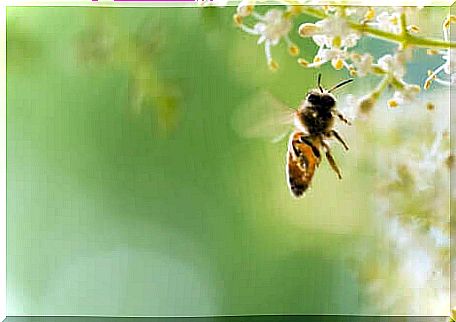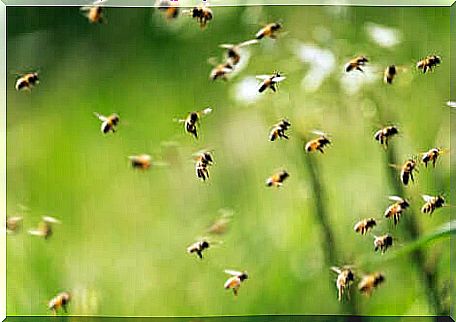Fear Of Bees Or Apiphobia, A Widespread Phobia

Many people fear or reject insects. They sometimes even end up developing an irrational fear of them. Among the most common phobias of insects is apiphobia, the fear of bees, wasps or bumblebees. Just seeing one of these insects flying around can trigger extremely unpleasant symptoms.
Even though this is a fairly peaceful animal to humans and fundamental to nature’s cycle, bees trigger real panic in more people than you might think. In fact, it is calculated that around 3% of the population is afraid of bees.

Symptoms of apiphobia
Apiphobia or excessive fear of bees is also known as melissophobia, after their Greek name ( melissa ). As the name suggests, it is an anxiety disorder, and more specifically a phobia. This type of disorder occurs when, in the face of a stimulus – in this case, wasps, bees or bumblebees – one feels a very intense or irrational fear.
In addition to this feeling of fear, the person experiences discomfort and anxiety. Thus, among the symptoms of a more physiological character, the most common are: dizzy spells, dizziness, increased heart rate, hyperventilation or difficulty in breathing, nausea, tremors, a headache, feeling of loss of consciousness, etc.
There are also cognitive symptoms, which are symptoms that affect a person’s thoughts. A person with apiphobia would display a lack of concentration, intrusive thoughts about the possibility of more bees appearing, thoughts of death, or biased thoughts about the situation.
Finally, as in the majority of anxiety disorders, two behavioral symptoms inevitably appear: avoidance and flight. These behaviors are completely natural when we are faced with a threatening situation.
Thus, a person who has a phobia of bees will try to avoid being in their presence at all costs. If that is not possible, as soon as she notices one, she will immediately flee.
Where does the fear of bees come from?
When we talk about phobias, we often take into account two possible causes. On the one hand, a personal traumatic experience with bees, or an experience linked to a close person. It is common to get stung by these insects and, due to the pain of their bites, it is an experience that no one would like to relive.
If we compare apiphobia to other animal phobias, fear of bees is not so irrational fear, because stings can pose a health risk. Nevertheless, the severity of a wasp attack is determined by whether the person is allergic or by the number of simultaneous bites.
Phobias are also the consequence of vicarious learning. If, when we were children, we had a loved one who was afraid of bees, it is likely that that loved one transmitted that fear to us, or that we simply learned the avoidance behavior.
These loved ones may have reinforced our fear. How? ‘Or’ What ? By constantly alerting us to the dangers (real or not) of these animals, for example.
The consequences of fear of bees
Usually, animal phobias appear during childhood. At this stage of life, it does not generate great consequences, apart from a certain discomfort. Animal phobias tend to disappear over the years.
However, in the event that they do not go away, the fear will remain or increase, which can affect daily life. Here we must emphasize the difference between being afraid and having a phobia.
When it comes to a phobia, fear ends up limiting our life. For example, it can determine where we go to buy a house or whether we abandon the one we live in.
We can stop going to concrete places, even when we want to, for fear of falling on bees. And we may even experience symptoms of anxiety when arriving at a place full of flowers, as bees could appear.
If we take all of this into account, apiphobia can have mild or severe consequences depending on how it affects a person’s life. It is, however, an anxiety disorder that should be treated and resolved in order for the person to have a better quality of life.

Treatments
For phobias, cognitive behavioral therapy is the most effective treatment. More concretely, three intervention strategies are applied: relaxation, modification of phobic and irrational thoughts and systematic desensitization or exposure techniques.
Since this is an anxiety disorder, it is fundamental that the person learns and acquires the resources to deal with the stimulus or to relax during a panic attack.
For this, he will be taught techniques of progressive muscle relaxation or endogenous relaxation. These tools will be useful to him during the initiation of systematic desensitization.
Whether through the latter technique or another strategy, exposure to frightening stimuli should be gradual. We will therefore begin, for example, to work with images. And, little by little, we will bring the person closer to the real stimulus, until he is able to do it without feeling deep anxiety.
Ultimately, an irrational or very intense fear of bees is a phobia and as such should be treated with a professional in psychology. The person will thus be able to improve their quality of life and carry out activities that they would have been unable to do before because of their fear.










